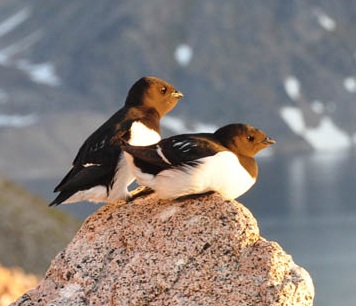May 15 2012
With climate change affecting the entire globe, especially the polar regions, how are different species adapting to the change in temperature? An international team led by a CNRS researcher from the Center for Functional and Evolutionary Ecology has found that little auks, the most common seabirds in the Arctic, are changing their fishing behaviour to cope with the warming surface waters in the Greenland Sea.
So far, their reproductive and survival rates have not been affected. However, further warming could threaten the species. This research, supported in particular by the French Polar Institute (IPEV) and a US-Norwegian program, is published in the journal Marine Ecology Progress Series dated 21 May 2012.
 Two litttle auks enjoying the midnight sun, East Greenland. Image Credit: © David Grémillet
Two litttle auks enjoying the midnight sun, East Greenland. Image Credit: © David Grémillet
Little auks are among the smallest (150 g) and most common (40-80 million) seabirds in the North Atlantic. They inhabit the rocky coasts of Greenland and Spitsbergen. To feed themselves and their chicks, they specialize in foraging for small planktonic crustaceans called copepods(3), catching up to 65,000 individuals each day. The birds seek out cold current areas, avoiding more temperate waters. Indeed, the icy waters flowing south from the Arctic Ocean via the Fram Strait, between Greenland and Spitsbergen, are home to large Arctic copepods, Calanus hyperboreus, which are very rich in fat. Another species of copepod, C. finmarchicus, thrives in more temperate waters, but it is smaller and supplies less energy. Because of their specialized diet and high food intake, little auks are a reliable indicator for testing the impact of climate change on this region.
For three years, in summer, the researchers studied three colonies of little auks on either side of the Greenland Sea. The difference in surface water temperatures between the warmest and coldest site is 5°C. The warmest site, located in Spitsbergen, reproduces the conditions predicted for the late 21st century in the coldest site (East Greenland). Such temperature differences lead to major changes in the abundance and average size of zooplankton, reducing the quality of little auks' food resources (copepods).
Surprisingly, the birds have managed to make up for the warming of surface waters in the Greenland Sea by altering their diet and extending the duration of their foraging trips at sea. They travel further and for longer in order to feed in areas where foraging is more successful.
So far, little auks have therefore managed to adapt to the effects of warming surface waters in the Greenland Sea. However, a 5°C temperature rise remains below the maximum temperature increase of 7°C predicted by climate models for the Arctic in 2100. Yet it seems that little auks have reached the limits of their physiological and behavioural capacities. More intense warming could therefore cause their decline as well as a major disruption of marine ecosystems in the Arctic. The scientists are now investigating the impact of global warming on the winter survival of these seabirds.